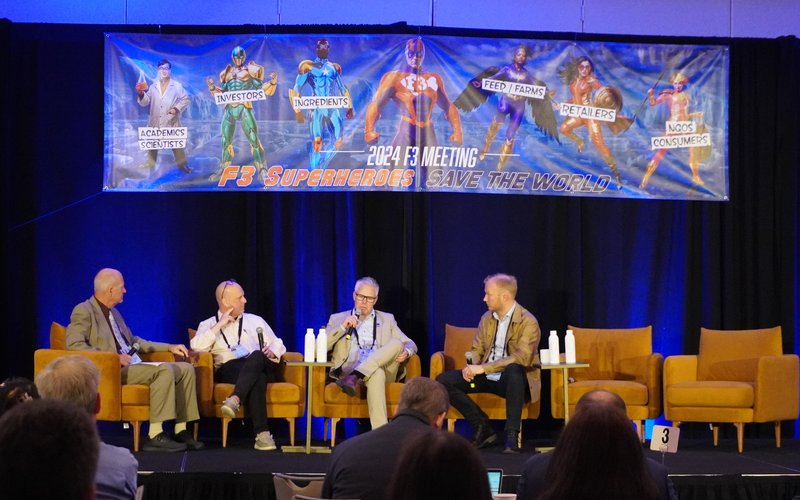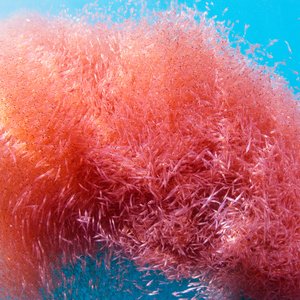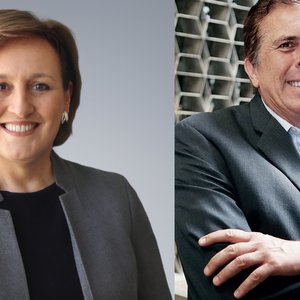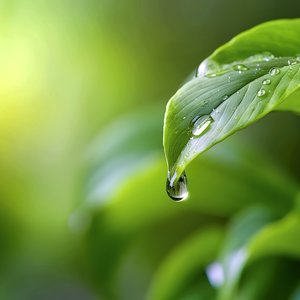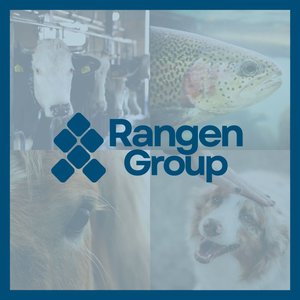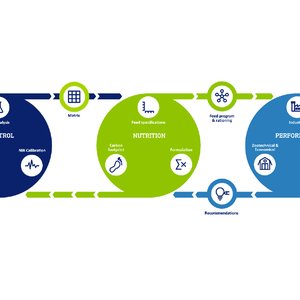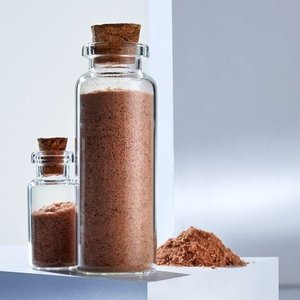In the past 30 years, the aquafeed industry has been on a journey to reduce and replace fishmeal and fish oil in its formulas. Throughout these years, extensive research has been done showing many alternatives that have allowed the aquafeed industry to reduce the use of marine-based ingredients to current levels. The Future of Fish Feed (F3) has compiled this information in the Feed Innovation Network, which provides resources on experimental protocols, testing facilities, and new ingredients.
To support this move, the F3 has also launched four challenges in the past few years looking to replace marine-based ingredients. At the recently held F3's biannual meeting that took place in San Francisco, some initiatives resulting from the challenges that are already on the market were discussed. “With the last challenge with red sea bream, we got some good results compared with the marine control diet. We were 10% less, but the results that we got were interesting enough so we decided that we needed to invest in black soldier fly and take a strategic position there to make sure that we can have sustainable raw materials for our fish-free feeds,” said Boyd Way, director, foreign trade manager at Dainichi Corporation, at the meeting.
Jiangsu Fuhai Biotech was the winner of the latest F3 Challenge in the Other Carnivorous Species category and has been raising fish-free fish in China with good growth performance, palatability and taste. “Last year, in a conference in Zhanjiang, over 300 people tested our fish and they liked it,” said Zhijun Hu, CEO at Jiangsu Fuhai Biotech Co.
Advances in China
Since China produces 60% of the world’s aquaculture production and represents roughly one-third of the global demand for fishmeal, the meeting hosted a special session to discuss how the local industry is facing the challenge of low supplies of marine ingredients and the strategies of the feed companies to reduce marine-based ingredients.
“In the past 20 years, China’s total aquaculture production increased from 17 million tons to 35 million tons, a production increase of 106%, but fishmeal production only increased by 40%. The improvement of the feed formula and the replacement with other proteins have been key,” said Cui He, president of China Aquatic Products Processing and Marketing Association.
Yuehai Feed Group was one of the companies at the meeting that reported significant technological progress in replacing fishmeal and fish oil in the past five years in some species, such as shrimp, golden pompano, seabass, snakehead fish, etc. “For example, zero fishmeal and fish oil can already be achieved on freshwater fish feed; more than half of the fishmeal and fish oil can be replaced in special fish feed; and half of the fishmeal and most of the fish oil can be replaced in shrimp feed,” said Xuezhi Zhu, technical director at Yuehai Feed Group.
“Shrimp and carnivorous fish feed generally contain low fishmeal. The commercial formula can't achieve the true zero fishmeal maintaining the growth and nutritional health of the animals at the same time. Our company focuses on the development of new protein sources and functional additives. We plan to replace fishmeal with new protein sources such as single-cell protein, enzymatically hydrolyzed plant protein and insect protein,” Zhu said.
Enhancing the functionality and digestibility of ingredients through enzyme analysis of marine and terrestrial animal proteins, as well as the fermentation of plant proteins, is another strategy adopted by Shenzhen Alpha Feed. “In the future, AlphaFeed will pursue innovations in fishmeal and fish oil processing, such as low-temperature drying of fishmeal to prevent protein denaturation and oxidation prevention for fish oil. The company aims to improve the biological potential of fishmeal, promote the substitution of fish oil with algae, and support the large-scale development and utilization of single-cell protein,” the company said.
In reducing fishmeal, carnivorous species have been the most challenging due to their high protein requirements. However, it has been possible to reduce fishmeal without losing efficiency. “Based on our research, the minimum diet fishmeal level for largemouth bass, golden pompano, and large yellow croaker could be reduced to 8%, 14%, and 16%, respectively. Compounded protein ingredients and functional additives should be useful tools to formulate a low fishmeal diet,” reported Yan Wang, Ocean College, Zhejiang University, China.
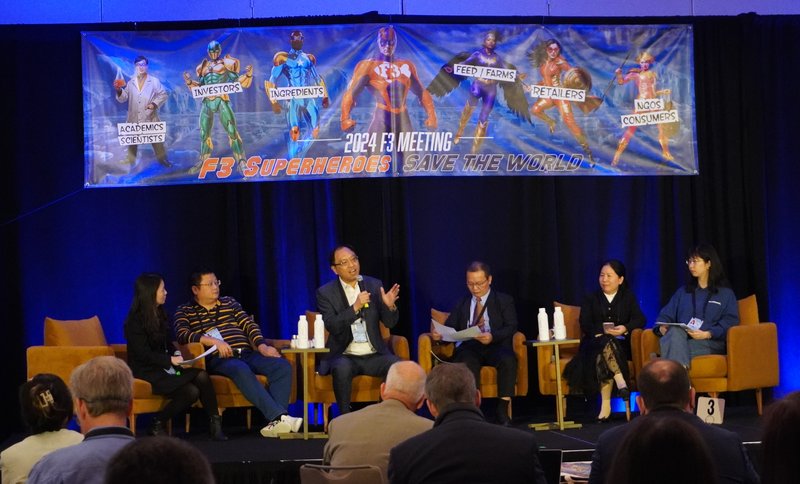
Chinese feed panel at the F3's Annual Meeting. From left to right: Dan LUO, FishFirst; Jipeng XUE, Bosar; Zhijun HU, Jiangsu Fuhai Biotech Co.; Cui HE, China Aquatic Products Processing and Marketing Association; Xuezhi ZHU, Yuehai Feed Group; Yuchi CHEN, Guangdong Evergreen Feed Co.
Formulation with novel ingredients
At the meeting, Vidar Gundersen, global sustainability director at BioMar, predicted the utilization of around 30% of novel ingredients (20% SCPs and 12% insect meal) in 2030 in Norway aquafeeds. This is the case of salmon, where nutritional requirements have been deeply investigated, but that’s just a small percentage of the whole aquaculture industry.
“We feed a lot of species, especially marine species, that are relatively new to aquaculture such as cod, halibut, and grouper. There is a lot of knowledge available, but there's still a lot we don't know yet. We see the potential to decrease the marine ingredients in these feeds but we need options that really work,” said Anders Bylling, Group CEO & vice president at Aller Aqua.
Other species such as shrimp are currently being over-formulated. “This is the case in Asia. Ecuador is starting to be a little bit less over-formulated than some other places with the price pressures that are around there. Shrimp farming in Asia started with Pennaeus monodon, which is a much more carnivorous species, and it's always going to be over-formulated,” said Craig Browdy, CTO at SyAqua. “Taking advantage of the vannamei strains that are being cultured today, and particularly some of the genetic lines that are being developed, we're able to significantly reduce that protein need and more efficiently convert the protein.”
Some alternative ingredients, particularly fermented ingredients, have shown beneficial properties on the shrimp's immune system. “That is important in larval feeds. Since biomasses are small, you are able to take some of these novel ingredients that aren't really produced even at scale yet and show that they are able to be used. That helps the company that is developing these ingredients to show that they have a commercial application, even at a small scale. So larval feeds are a very interesting laboratory to play with,” Browdy said.
The farmers’ perspective
The aim of feed companies is to provide the best solution for farmers with the available resources. In times of low fishmeal and fish oil supplies and when introducing new ingredients in the formula, aquafeed companies need to convince farmers that the quality of their aquafeeds remains the same.
“There is somewhat of a legacy of having lots of fishmeal, fish oil, and farmers being told that it should smell fishy, it should be oily in the hand. They were told that for so long and now, the industry is transitioning to convince them that they don’t need that much in there and that there are alternatives that we can use,” said Kevin Fitzsimmons, professor at the University of Arizona.
“In the EU, the biggest raw material is the first one on the label and if fishmeal isn't the first one for the starter feeds, the farmers will notice. These are the kinds of hurdles we need to get over. There is little trust between farmers and feed companies,” Bylling said. “Krill is the same case. Chinese customers getting starter feeds that are not reddish means for them the feed company is skipping krill.”
“We need to meet the SBTi targets but we also need to make farms efficient, and long-term sustainable, both from an economic and an environmental point of view,” Bylling said. “There's an acceptance on the farmer level, later on the processor and retailer and that takes time. We need to stick with it and see this as a long run.”
Educating the whole value chain
Not only do farmers need to be educated and informed about the “new generation” of aquafeeds, but the whole value chain needs to get involved. “This industry is still relatively young, but it is also very conservative in many areas. It's not just about consumer education but it is also educating within the value chain,” Gundersen said.
“We need partnerships to go all the way through to the retailer. You can create any new product but there needs to be someone who wants to pay for that. We need to have a Coalition of the Willing,” said Kristin Veriga, senior leader of Strategic Feed Initiatives, eFishery.
“You need to have the retailers so they can go out and educate the public in terms of why we're using these ingredients and their benefits,” Way said.
Jen Kemmerly, vice president of global ocean conservation at the Monterey Bay Aquarium, said that aquaculture as an industry was villainized. “Monterey Bay Aquarium and all of our NGO peers have been working for over a decade to try to work on the stigma around aquaculture. Consumers and businesses need accessible information if we want them to source from aquaculture operations and not continue to villainize the industry. We have to do better at rewarding better performers and continue to innovate.”
In Europe, there are moreover other legislative issues. “The EU is feed safety oriented. After mad cow disease, PAPs cannot be used and there is a consumer rejection of GM material. Retailers are the ones controlling this, but there is change coming with legislation opening up,” Gundersen said.
Sustainability
While educating, sustainability has become one of the key reasons for convincing consumers. The industry is using life cycle assessment as the method to assess aquafeeds or aquaculture production, but it needs to be carefully performed to make sure it takes into account all potential impacts.
This year’s F3 meeting embraced a superhero theme to honor the impact that each stakeholder – investors, ingredients, feed & farms, academics & scientists, retailers, and consumers & NGOs – can have on transitioning the aquaculture industry to sustainability.
Peter Tyedmers, professor at Dalhousie University School for Resource and Environmental Studies, explained that in this “Justice League”, there are also super-villains when it comes to sustainability: the parser that only tells one side of the story, for example, a company focusing on reducing dependence on aquatic resources, and other on gas emissions, and both claiming sustainability; the quick pick that makes people choose fast, for example, while claiming organic production is better than conventional; the hydra that appears when you solve one problem and get a new one, for example, replacing marine ingredients with plant-based ingredients; and the allocator that tells you how much of certain things you are taking care of.
“The blindness of our own limitations of knowledge and how we are able to understand them is a problem in and of itself. It's easy to quantify greenhouse gas emissions from burning diesel and producing concrete, but there are sets of emissions that we can recognize, but we don't quantify well,” Tyedmers.
“A lot of these villains are known knowns. The werewolf is not one of our villains because we can't use silver bullets on this. There is no single solution, this is like a ‘Justice League’, you have to have everybody working together towards a solution,” said Michael Tlusty, F3 judge and associate professor of Sustainability and Food Solutions at the University of Massachusetts Boston.
The current F3 Challenge is doing its part in bringing the industry together and is looking for solutions to replace krill from aquafeeds. Ten companies were selected with trials currently underway and winners to be announced in early 2025. The challenge will continue to bring knowledge and support the industry in its path to reduce or replace marine ingredients in aquafeeds.
Read more about the meeting:


